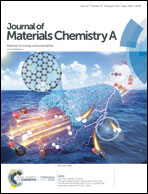Surface evolution and reconstruction of oxygen-abundant FePi/NiFeP synergy in NiFe phosphides for efficient water oxidation†
Abstract
Transition-metal phosphides are promising materials for efficient water oxidation, but the elements often leach or suffer corrosion under the harsh electrochemical oxidation environment, leading to surface reconstruction. Herein, we employ a weak electrochemical activation protocol at the marginal positive potential (−0.3–0.5 V vs. reversible hydrogen electrode [RHE]) to investigate the surface optimization and evolution of nickel-iron phosphides. The as-formed oxygen-abundant FePi/NiFeP synergy contributes to the enhanced catalytic activity, which requires only 210 mV and 270 mV to achieve 10 mA cm−2 and 100 mA cm−2 in 1.0 M KOH, respectively. This work provides new evidence on the surface evolution and adaptive reconstruction of transition phosphides for efficient water oxidation. The greater understanding of pre-catalysts may inspire more rational design strategies for efficient electrocatalysts.



 Please wait while we load your content...
Please wait while we load your content...